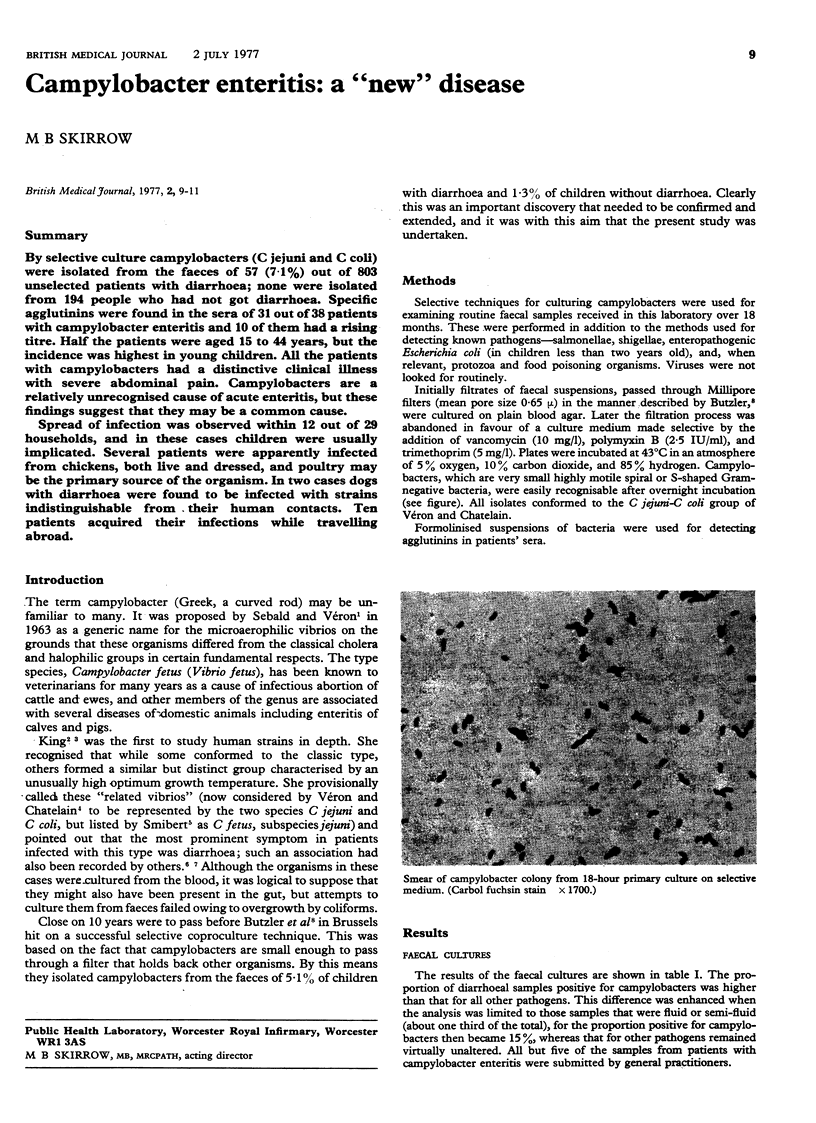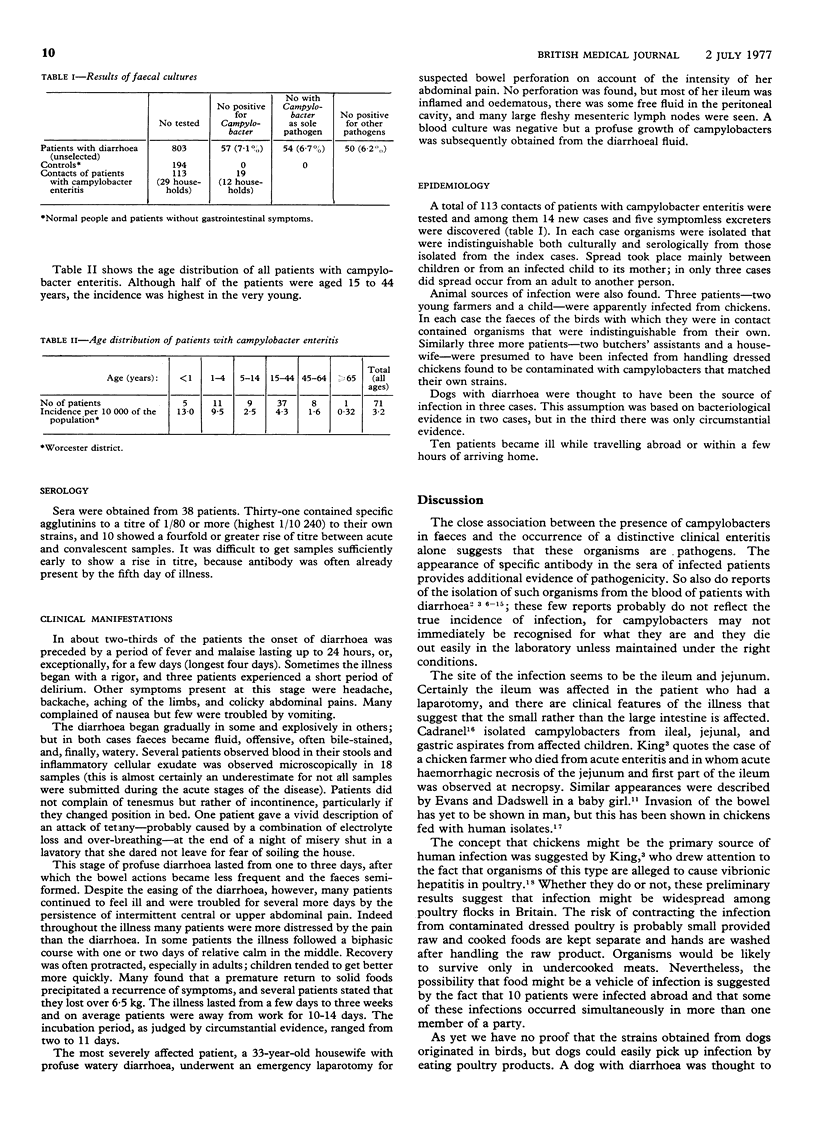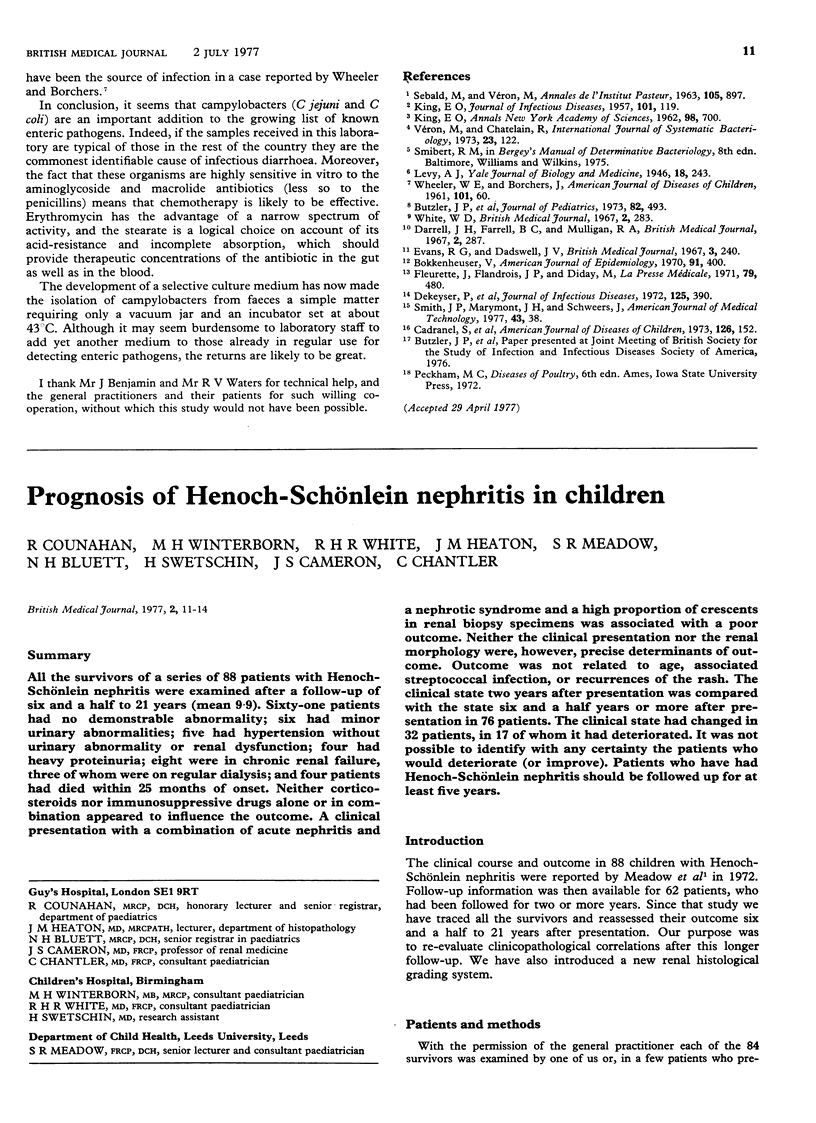Abstract
By selective culture campylobacters (C jejuni and C coli) were isolated from the faeces of 57 (7-1%) out of 803 unselected patients with diarrhoea; none were isolated from 194 people who had not got diarrhoea. Specific agglutinins were found in the sera of 31 out of 38 patients with campylobacter enteritis and 10 of them had a rising titre. Half the patients were aged 15 to 44 years, but the incidence was highest in young children. All the patients with campylobacters had a distinctive clinical illness with severe abdominal pain. Campylobacters are a relatively unrecognised cause of acute enteritis, but these findings suggest that they may be a common cause. Spread of infection was observed within 12 out of 29 households, and in these cases children were usually implicated. Several patients were apparently infected from chickens, both live and dressed, and poultry may be the primary source of the organism. In two cases dogs with diarrhoea were found to be infected with strains indistinguishable from their human contacts. Ten patients acquired their infections while travelling abroad.
Full text
PDF


Images in this article
Selected References
These references are in PubMed. This may not be the complete list of references from this article.
- Bokkenheuser V. Vibrio fetus infection in man. I. Ten new cases and some epidemiologic observations. Am J Epidemiol. 1970 Apr;91(4):400–409. doi: 10.1093/oxfordjournals.aje.a121150. [DOI] [PubMed] [Google Scholar]
- Butzler J. P., Dekeyser P., Detrain M., Dehaen F. Related vibrio in stools. J Pediatr. 1973 Mar;82(3):493–495. doi: 10.1016/s0022-3476(73)80131-3. [DOI] [PubMed] [Google Scholar]
- Cadranel S., Rodesch P., Butzler J. P., Dekeyser P. Enteritis due to "related vibrio" in children. Am J Dis Child. 1973 Aug;126(2):152–155. doi: 10.1001/archpedi.1973.02110190134004. [DOI] [PubMed] [Google Scholar]
- Darrell J. H., Farrell B. C., Mulligan R. A. Case of human vibriosis. Br Med J. 1967 Apr 29;2(5547):287–289. doi: 10.1136/bmj.2.5547.287. [DOI] [PMC free article] [PubMed] [Google Scholar]
- Dekeyser P., Gossuin-Detrain M., Butzler J. P., Sternon J. Acute enteritis due to related vibrio: first positive stool cultures. J Infect Dis. 1972 Apr;125(4):390–392. doi: 10.1093/infdis/125.4.390. [DOI] [PubMed] [Google Scholar]
- Fleurette J., Flandrois J. P., Diday M. Méningites et diarrhées à "Vibrio foetus". A propos d'un cas chez un nourrisson. Presse Med. 1971 Feb 27;79(11):480–482. [PubMed] [Google Scholar]
- KING E. O. Human infections with Vibrio fetus and a closely related vibrio. J Infect Dis. 1957 Sep-Oct;101(2):119–128. doi: 10.1093/infdis/101.2.119. [DOI] [PubMed] [Google Scholar]
- SEBALD M., VERON M. TENEUR EN BASES DE L'ADN ET CLASSIFICATION DES VIBRIONS. Ann Inst Pasteur (Paris) 1963 Nov;105:897–910. [PubMed] [Google Scholar]
- Smith J. P., Marymont J. H., Jr, Schweers J. Septicemia due to Campylobacter fetus in a newborn infant with gastroenteritis. Am J Med Technol. 1977 Jan;43(1):38–40. [PubMed] [Google Scholar]
- WHEELER W. E., BORCHERS J. Vibrionic enteritis in infants. Am J Dis Child. 1961 Jan;101:60–66. doi: 10.1001/archpedi.1961.04020020062010. [DOI] [PubMed] [Google Scholar]
- White W. D. Human vibriosis: indigenous cases in England. Br Med J. 1967 Apr 29;2(5547):283–287. doi: 10.1136/bmj.2.5547.283. [DOI] [PMC free article] [PubMed] [Google Scholar]



